A) meandering stream
B) braided stream
C) a stream whose main channel has high sinuosity
D) an esker
Correct Answer

verified
Correct Answer
verified
Multiple Choice
At which site along this stream would a point bar form? 
A) A
B) B
C) C
D) D
Correct Answer

verified
Correct Answer
verified
Multiple Choice
What is the discharge of the stream shown in the accompanying figure if the velocity is 2 meters per second? 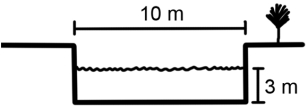
A) 300 cubic meters per second
B) 60 cubic meters per second
C) 32 cubic meters per second
D) 15 cubic meters per second
E) none of these
Correct Answer

verified
Correct Answer
verified
Multiple Choice
Which of the following is a condition favoring deposition of sediment?
A) an increase in water velocity
B) a decrease in gradient of the stream
C) an increase in turbulence of the water
D) an increase in the salt content of the water
E) a decrease in grain size as a clast breaks into two pieces
Correct Answer

verified
Correct Answer
verified
Multiple Choice
Stream terraces represent:
A) older floodplains of a river that has incised downward
B) cutoff meanders of a meandering stream
C) areas where sea level has risen and waves beveled across the coast
D) none of these
Correct Answer

verified
Correct Answer
verified
Multiple Choice
Which of the following influences whether a flood occurs?
A) the height of levees
B) the amount of discharge
C) urbanization (replacing farms or natural land with buildings)
D) the width of the channel
E) all of these are influences
Correct Answer

verified
Correct Answer
verified
Multiple Choice
Which of the following can have a significant effect on a river?
A) rises and drops in sea level
B) tectonics
C) types of bedrock in the river
D) changes in climate
E) all of these
Correct Answer

verified
Correct Answer
verified
Multiple Choice
The accompanying figure shows a series of river terraces.Which two of these terraces are probably closest in age? 
A) A and B
B) B and C
C) C and D
D) A and C
Correct Answer

verified
Correct Answer
verified
Multiple Choice
Where do mountain streams get most of their load of sediment?
A) landslides,slope failures,and erosion of the mountain sides
B) downward incision into bedrock
C) abrasion of bedrock along the bottom of the channel
D) alluvial fans
Correct Answer

verified
Correct Answer
verified
Multiple Choice
Which of the lettered sites would most likely be undercut by migration of a meander? 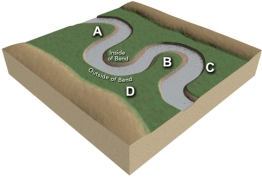
A) A
B) B
C) C
D) D
Correct Answer

verified
Correct Answer
verified
Multiple Choice
For the same discharge,which site is most likely to be flooded? 
A) A
B) B
C) C
D) D
Correct Answer

verified
Correct Answer
verified
Multiple Choice
What type of feature is shown in this figure? 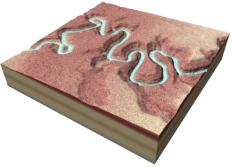
A) a braided stream
B) river terraces
C) alluvial fans
D) entrenched meanders
E) none of these
Correct Answer

verified
Correct Answer
verified
Multiple Choice
Which of the following is true about the base level of a stream:
A) Base level indicates the normal (or base) flow level before flooding.
B) The flat top of a mountain is the ultimate base level for most streams.
C) A mountain is close to its base level if bedrock is close to the surface.
D) Most streams have lower gradient close to their base level.
E) Base level generally is near the steepest part of a stream's profile.
Correct Answer

verified
Correct Answer
verified
Multiple Choice
The gradient of the stream between the two ends on the accompanying figure is: 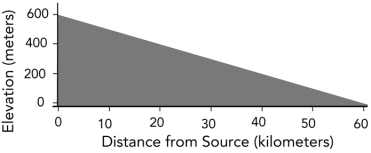
A) 1 meter per kilometer
B) 10 meters per kilometer
C) 100 meters per kilometer
D) 1 to 1
E) 6 to 1
Correct Answer

verified
Correct Answer
verified
Multiple Choice
Which of the following features is NOT present along the Colorado River?
A) delta
B) entrenched meanders
C) tributaries that start in high mountains
D) evidence for large prehistoric floods
E) all of these are present
Correct Answer

verified
Correct Answer
verified
Multiple Choice
The accompanying figure shows a series of river terraces.Which of these terraces is the youngest? 
A) A
B) B
C) C
D) D
Correct Answer

verified
Correct Answer
verified
Multiple Choice
What could cause this stream to deposit sediment? 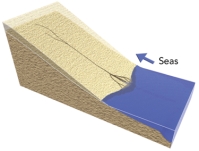
A) a rise in base level,such as a rise in sea level
B) subsidence of the land,producing slopes that are less steep
C) both a rise in base level or subsidence of the land
D) none of these
Correct Answer

verified
Correct Answer
verified
Multiple Choice
What is the most important data for studying the potential for flooding along a river for several decades into the future?
A) precipitation records
B) newspaper accounts of previous floods
C) satellite photographs taken every ten years
D) discharge data from stream gauges
Correct Answer

verified
Correct Answer
verified
Multiple Choice
Where would be the relatively safest place to build a bridge across the stream in the accompanying figure? 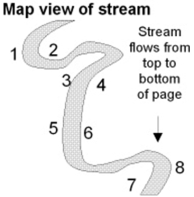
A) between points 1 and 2
B) between points 3 and 4
C) between points 5 and 6
D) between points 7 and 8
Correct Answer

verified
Correct Answer
verified
Multiple Choice
Which of the following is unlikely to cause deposition of sediment along a stream?
A) a decrease in gradient
B) a decrease in water velocity
C) a drop in sea level
D) none of these
Correct Answer

verified
Correct Answer
verified
Showing 81 - 100 of 109
Related Exams